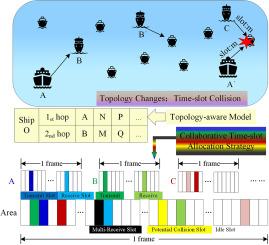Topology-aware model for collaborative time-slot allocation in maritime ad hoc networks
IF 4.8
3区 计算机科学
Q1 COMPUTER SCIENCE, INFORMATION SYSTEMS
引用次数: 0
Abstract
The strongly time-varying topology of time-division multiple access (TDMA)-based maritime ad hoc networks (MANETs) leads to their low robustness and poor link stability, resulting in a high time-slot collision rate and poor communication-resource utilization. To address these problems, based on the ant colony algorithm (ACA), this research proposes a collaborative time-slot resource optimization allocation strategy for ships. The proposed strategy involves first constructing a topology-aware model, then updating the involved network topology in real time and identifying the network’s center of gravity based on dynamic clustering coefficients, and finally utilizing the pheromone matrix of the ACA for time-slot allocation, realizing optimal dynamic scheduling. Simulation results based on actual ship automatic identification system (AIS) data show that compared to RATDMA, SOTDMA, and BSO-TDMA, the proposed strategy achieves significantly better performance; it exhibits a 39% lower time-slot occupancy rate, an 87% lower collision rate, and a >95% higher network throughput compared to those obtained using RATDMA. Overall, our strategy achieves time-slot collision minimization and performance reliability enhancement for ensuring secure communication in highly dynamic MANETs.

海上自组织网络协同时隙分配的拓扑感知模型
基于时分多址(TDMA)的海上自组织网络(manet)的强时变拓扑结构导致其鲁棒性低,链路稳定性差,导致时隙碰撞率高,通信资源利用率低。针对这些问题,本研究基于蚁群算法,提出了一种船舶协同时隙资源优化分配策略。该策略首先构建拓扑感知模型,然后实时更新所涉及的网络拓扑并基于动态聚类系数识别网络重心,最后利用蚁群算法的信息素矩阵进行时隙分配,实现最优动态调度。基于实际船舶自动识别系统(AIS)数据的仿真结果表明,与RATDMA、SOTDMA和BSO-TDMA相比,所提策略的性能显著提高;与使用RATDMA相比,它的时隙占用率降低39%,冲突率降低87%,网络吞吐量提高95%。总体而言,我们的策略实现了时隙冲突最小化和性能可靠性增强,以确保高动态manet中的安全通信。
本文章由计算机程序翻译,如有差异,请以英文原文为准。
求助全文
约1分钟内获得全文
求助全文
来源期刊

Ad Hoc Networks
工程技术-电信学
CiteScore
10.20
自引率
4.20%
发文量
131
审稿时长
4.8 months
期刊介绍:
The Ad Hoc Networks is an international and archival journal providing a publication vehicle for complete coverage of all topics of interest to those involved in ad hoc and sensor networking areas. The Ad Hoc Networks considers original, high quality and unpublished contributions addressing all aspects of ad hoc and sensor networks. Specific areas of interest include, but are not limited to:
Mobile and Wireless Ad Hoc Networks
Sensor Networks
Wireless Local and Personal Area Networks
Home Networks
Ad Hoc Networks of Autonomous Intelligent Systems
Novel Architectures for Ad Hoc and Sensor Networks
Self-organizing Network Architectures and Protocols
Transport Layer Protocols
Routing protocols (unicast, multicast, geocast, etc.)
Media Access Control Techniques
Error Control Schemes
Power-Aware, Low-Power and Energy-Efficient Designs
Synchronization and Scheduling Issues
Mobility Management
Mobility-Tolerant Communication Protocols
Location Tracking and Location-based Services
Resource and Information Management
Security and Fault-Tolerance Issues
Hardware and Software Platforms, Systems, and Testbeds
Experimental and Prototype Results
Quality-of-Service Issues
Cross-Layer Interactions
Scalability Issues
Performance Analysis and Simulation of Protocols.
 求助内容:
求助内容: 应助结果提醒方式:
应助结果提醒方式:


